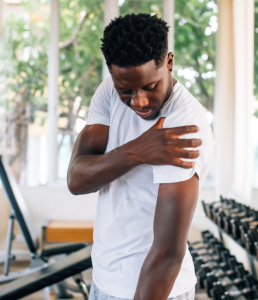The shoulder is the most mobile joint in the body. As you age, certain structures become more vulnerable to damage. This may be the result of standard degeneration, trauma, overuse, or any combination of the three. The rotator cuff, a group of muscles and tendons that surround the shoulder joint and stabilize the upper arm in the shoulder socket, is the most vulnerable area.
While aging increases the chance of injury, you can reduce the risk of getting hurt with adequate exercise and mindful habits. We’re sharing some tips on how to take care of your aging shoulders.
Keep Moving:
Exercise can yield positive effects on aging bodies and keep adults active and healthy. Shoulder exercises in particular may fight osteoporosis, stabilize support muscles, slow age-related muscle deterioration, and improve function and control. Don’t forget to warm up! A proper warm up, such as stretching or a brisk walk, will help get oxygen moving through the muscles, making them more pliable and improving recovery time. Here are a few exercises you can do at home once you’re all warmed up. Be mindful of your current strength and capabilities when selecting weights for certain exercises.
- Overhead Elbow Extension – Do you want to retain the ability to reach high above your head? Then give overhead elbow extensions a try! Bend your arm, with your palm side facing the shoulder and raise the elbow until the arm holding the weight is positioned behind you. Next, straighten your arm bringing the weight over your head. Repeat ten times. If you feel strain on your back, try completing the exercise by sitting in a chair with back support.
- Shoulder Rolls – Shoulder rolls stabilize the shoulder blades, improving mobility and the ability to lift heavy objects. To do shoulder rolls, stand with your feet shoulder width apart, holding your selected weights. Then, being raising your shoulders to your ears. Gently bring the shoulders backward and then down. Breathe when bringing your shoulders back up. Be sure to keep your elbows extended and direct movement from the shoulder. Repeat 15 times.
- Side Shoulder Raise – Side shoulder raises strengthen the chest, shoulder, and upper arms. This exercise improves the ability to perform daily tasks such as opening heavy doors or pushing a shopping cart. To start, position the arm supporting the weight straight down your side with the palm facing forward. Next, raise your arm outward to the side and above your head. Repeat ten times. Your elbows should be slightly flexed while bringing the weight down slowly and with control.
- Resistance Bands – This exercise is easily modifiable to individual needs and preferences. Stand with your shoulders lightly against the wall. Take a resistance band and stretch the band between your forearms. Move your right shoulder in circles, going in both directions, against the wall. Repeat 10 times then repeat the exercise with the left shoulder.
Optimize Your Ergonomics:
For office workers, years of slouching over a work station often leaders to shoulder pain and muscle stiffness. Utilizing ergonomic materials during the work day can help combat rounded shoulders from a slumped posture. Here are some important factors to consider:
- Sit with your back straight and fully supported by the char. The shape of the chair should have a natural curve to offer lumbar support. If your chair is now equipped, you can always add a lumbar pillow.
- Maintain a 90-120 degree bend in your elbows and knees when siting.
- Adjust your desk height to allow your arms to comfortable rest on the desk top.
- A poorly placed monitor is a big culprit of neck and shoulder pain. Position your monitor so it is about 20 inches in front of you – the top of the computer screen should be at eye level.
Mind Your Posture:
Forward arching of the spine due to aging coupled with tightness in the anterior chest can lead to shoulder impingement. The National Institutes of Health (NIH) reports that 44 to 65% of shoulder pain can be attributed to shoulder impingement syndrome. Mobility and stretching are key to avoiding impingement, while moving and strengthening your shoulders counteracts declining posture.
Schedule an appointment at Raleigh Orthopaedic
Call us at (919) 863-6996 or schedule 24/7 online at www.raleighortho.com to make an appointment with one of our orthopedic specialists. If your injury or condition is recent, you can walk right into one of our Raleigh Orthopaedic Urgent Care locations for immediate care. For rehabilitation and physical therapy, no referral is needed to see one of our physical therapists.

